| کد مقاله | کد نشریه | سال انتشار | مقاله انگلیسی | نسخه تمام متن |
|---|---|---|---|---|
| 6373679 | 1624323 | 2014 | 9 صفحه PDF | دانلود رایگان |
عنوان انگلیسی مقاله ISI
Evaluation of two organosilicone adjuvants at reduced foliar spray volumes in South African citrus orchards of different canopy densities
دانلود مقاله + سفارش ترجمه
دانلود مقاله ISI انگلیسی
رایگان برای ایرانیان
کلمات کلیدی
موضوعات مرتبط
علوم زیستی و بیوفناوری
علوم کشاورزی و بیولوژیک
علوم زراعت و اصلاح نباتات
پیش نمایش صفحه اول مقاله

چکیده انگلیسی
Citrus producers in South Africa generally use high spray volumes (6000 to 16,000 l haâ1) to control pests and diseases adequately for the fresh fruit market. In order to study the benefit of organosilicone adjuvants at reduced spray volumes, trials were conducted with two organo tri-siloxane adjuvants. Two separate spray trials were conducted in the Western and Eastern Cape provinces of South Africa in uniform navel orange orchards. Break-Thru S240 (super-spreader) and Break-Thru Union (spreader-sticker), at recommended dosages per hectare (300 ml haâ1, respectively), were sprayed separately in combination with a yellow fluorescent pigment (1 ml lâ1) at a high (20 l treeâ1 â 9600 to 12,100 l haâ1, depending on tree and inter-row spacing), medium (14 l treeâ1 â 6500 to 8500 l haâ1) and low (8 l treeâ1 â 3700 to 4800 l haâ1) spray application volumes. Sprays consisting of the fluorescent pigment in water alone were used as control treatments. Trees were sprayed from both sides with a commercial multi-fan tower sprayer (BSF-Multiwing) at a constant tractor speed (2.4 km hâ1) and spray pressure (1500 kPa). The different spray volumes were achieved by using different spray nozzles (TeeJet Disc-Core type; full and hollow cone nozzles D3-DC56/46, D4-DC56/46, D5-DC56/46). Leaves were sampled from six canopy positions (inner and outer canopy position at bottom, middle and top of the tree). Deposition quantity and quality of fluorescent pigment were determined on upper and lower leaf surfaces using fluorometry, digital photomacrography and image analyses. Spray uniformity and efficiency were also compared among treatments. Deposition quantity generally increased with increasing spray volume, but normalised values showed better spray efficiency at lower volumes. In pruned and less dense canopies, a beneficial effect of adjuvants was observed in terms of deposition quantity, efficiency and uniformity, especially at reduced volume applications (14 l treeâ1) on the inside and outside of the canopy. Little improvement in deposition quality was generally observed with the use of adjuvants. These benefits were not as evident in very dense canopies, illustrating the importance of canopy management when spraying at reduced volumes. Data obtained from the study is valuable for future improvement in spray application methodology in South Africa and other developing countries.
ناشر
Database: Elsevier - ScienceDirect (ساینس دایرکت)
Journal: Crop Protection - Volume 64, October 2014, Pages 198-206
Journal: Crop Protection - Volume 64, October 2014, Pages 198-206
نویسندگان
J. Gideon van Zyl, Ewald G. Sieverding, David J. Viljoen, Paul H. Fourie,